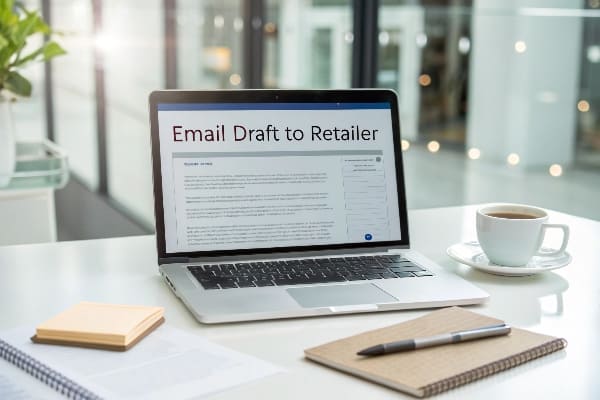If you’re looking to get your product into retail stores, you’re not alone. Many entrepreneurs, like me, face the challenge of breaking into the retail market. The key is a well-structured approach.
Getting retail stores to sell your product requires persistence and a clear strategy. But the process doesn’t need to be intimidating. You need to understand what stores want and how you can meet those needs.

Building a successful relationship with retail stores requires knowing the right steps to take. Let’s break down how to approach them effectively.
How do I get stores to sell my products?
Every business owner, myself included, has asked this question at some point. The challenge is real, but with the right approach, you can get your product on the shelves of major retail stores.
The first step is finding the right retail stores that align with your product. Not every store will be a good fit. Once you’ve identified the best options, you need to present your product in a way that shows its value to both the store and the customer.

Start by crafting a concise, compelling pitch. Retailers receive numerous product offers daily, so your pitch must stand out. Consider what makes your product unique—its quality, demand, or the value it can add to the retailer’s current offerings. Retailers are looking for products that will sell quickly and help them generate more revenue1.
Steps to Approach a Retailer
- Research Your Target Retailers: Understand the types of products they sell and their target customers2.
- Prepare Your Pitch: A clear, focused pitch showing how your product benefits their business.
- Offer Samples: Retailers often want to see and test the product before making a commitment.
- Negotiate Terms: Be ready to discuss wholesale pricing3, payment terms, and delivery logistics4.
How do you approach a retail store to sell your product email?
Email can be a powerful tool for reaching out to retailers, but it needs to be done right.
A well-crafted email can open the door for further discussions. The key is to keep it professional, concise, and personalized. Make sure the email speaks directly to the retailer’s needs and interests.

Here’s how you can structure your email:
- Subject Line: Keep it clear and interesting. For example, “Innovative Product That Will Appeal to Your Customers.”
- Introduction: Introduce yourself and your product briefly. Mention how you’ve researched their store and why you think your product would be a good fit.
- Body: Provide key selling points5 of your product and include any data or testimonials that support its success.
- Call to Action: Invite them to respond for more details or schedule a meeting.
- Close: Thank them for their time and consideration.
Sample Email Template
Subject: Innovative Cardboard Display Solutions for Your Store
Dear [Retailer’s Name],
I hope this message finds you well. My name is [Your Name], and I represent Popdisplay, a company specializing in creative, customizable cardboard displays designed to increase product visibility and sales.
I believe our products would be a great addition to your store, helping showcase [specific products they sell] in an eye-catching and cost-effective way. Our displays are customizable, eco-friendly, and proven to boost sales for many brands.
Please let me know if you would be interested in learning more or receiving a free sample.
Best regards,
[Your Name]
[Your Contact Information]
How do you approach a supermarket to sell your products?
Approaching a supermarket can be a little more complex than other types of retailers, especially because of the volume they deal with. But, with the right strategy, you can still make an impact.
Supermarkets prioritize high-demand products that customers will recognize and buy in large quantities. They also look for suppliers who can meet strict delivery schedules and provide products at competitive prices.

To successfully approach a supermarket, you need to focus on:
- Volume and Price6: Supermarkets want products that can be sold in large quantities. Offer pricing that makes sense for their business.
- Unique Selling Proposition (USP)7: Why is your product better than what they already have? Demonstrate the value.
- Consistency8: Supermarkets need reliable suppliers who can keep up with their demands. Show that you’re ready for the long haul.
Key Tips for Approaching Supermarkets
- Tailor Your Offer: Understand the supermarket’s target demographic and how your product fits their needs.
- Offer Bulk Discounts9: Supermarkets are looking for cost-effective deals that allow them to sell at a competitive price.
- Ensure Reliable Logistics10: They’ll want to know that you can deliver large quantities on time and with minimal hassle.
- Follow Up11: Don’t hesitate to follow up with the right people if you don’t hear back.
How do you approach a customer to sell your product?
Selling directly to customers is different from working with stores, but it can be just as rewarding. Building a personal connection with your customers is key to making a sale.
To approach customers effectively, you need to understand what they want. Customers are looking for solutions to their problems, whether it’s a product that improves their lifestyle or solves a pain point.

The best way to approach a customer is through relationship-building12 and showing them how your product can improve their lives. This can be done through various channels like face-to-face interactions, online marketing, or even personalized emails. You should also focus on creating a seamless buying experience13 and making it easy for them to trust you.
Steps to Approach Customers
- Identify Pain Points14: Know what problems your customers are facing and how your product solves them.
- Personalized Messaging15: Address your customers’ unique needs and offer solutions tailored to them.
- Clear Call to Action16: Make it easy for customers to buy or inquire about your product, whether it’s online or in person.
Tips for Customer Interaction
- Be Approachable: Ensure your sales team is approachable and knowledgeable about the product.
- Use Testimonials: Customer testimonials17 can be very powerful in building trust.
- Provide Value: Offering free samples18 or demonstrations can increase customer interest.
- Follow Up19: Always check in with potential customers to remind them of the value your product offers.
Conclusion
Approaching retail stores, supermarkets, or customers requires persistence, patience, and a clear understanding of their needs. With the right approach, your product can find its way to the shelves and into the hands of customers.
Explore insights on how retailers can enhance their revenue through innovative product offerings and strategic partnerships. ↩
Understanding target customers is crucial for tailoring your pitch and ensuring product-market fit. Explore this link for effective strategies. ↩
Negotiating wholesale pricing can significantly impact your profit margins. This resource will guide you through effective negotiation techniques. ↩
Efficient delivery logistics are vital for retailer satisfaction and customer experience. Discover best practices to streamline your logistics. ↩
Understanding key selling points can enhance your email marketing strategy and improve customer engagement. ↩
Finding the right balance between volume and price is crucial for success in supermarket sales; explore strategies to optimize this. ↩
Understanding USP can help you differentiate your product in a competitive market, making it more appealing to supermarkets. ↩
Learn why reliability is key for suppliers and how it can impact your relationship with supermarkets. ↩
Explore this link to learn how to create attractive bulk discount offers that can entice supermarkets and boost your sales. ↩
Discover best practices for logistics management to ensure timely and hassle-free deliveries to supermarkets, enhancing your business reputation. ↩
Learn effective follow-up techniques that can help you maintain communication and strengthen relationships with supermarket buyers. ↩
Exploring this resource will provide you with proven techniques to enhance customer relationships and boost loyalty. ↩
This link will guide you through best practices to streamline the purchasing process, ensuring customer satisfaction and retention. ↩
Understanding customer pain points is crucial for tailoring your approach and improving satisfaction. Explore this link for insights. ↩
Personalized messaging can significantly enhance customer engagement. Discover strategies to implement it effectively. ↩
A clear call to action can boost conversion rates. Learn the best practices to make your CTAs more effective. ↩
Exploring this resource will help you understand how testimonials can enhance trust and credibility in your business. ↩
This link will provide insights into the effectiveness of free samples in attracting and converting customers. ↩
Discovering best practices for follow-ups can significantly improve your customer engagement and conversion rates. ↩

